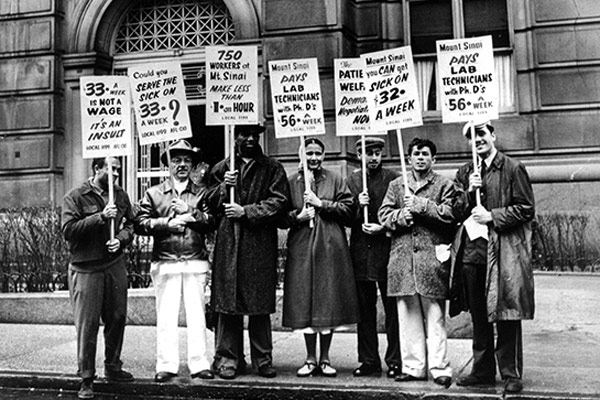A Look Back: 1199’s 46 Days That Turned New York Upside Down
May 7, 2014
Fifty-five years ago, a union of 5,000 drugstore workers led a 46-day strike that transformed New York City’s healthcare system by ending the super-exploitation of workers at some of the city’s most powerful hospitals.
David took on Goliath. When the strike began on May 8, 1959, management at the struck hospitals – Mount Sinai, Beth Israel, Bronx, Lenox Hill, Brooklyn Jewish, Beth David and Flower-Fifth Avenue – felt certain that turning back the workers and the strike would be relatively easy. They soon learned that they had greatly under-estimated the resolve of the 3,000 workers and the organizing genius of the 1199 leaders.
Led by President Leon Davis, Organizing Director Elliott Godoff and a small but dedicated staff, the workers rose to the occasion. Most also felt they had nothing to lose. The majority earned about $32 a week, with no healthcare coverage and few benefits. Many, in fact, qualified for public assistance.
“We also had right on our side and we were determined,” says Lena Hayes, president of the 1199SEIU Retirees Division, who at the time of the strike worked at Mt. Sinai Hospital. She later continued her education to become an RN.
Hayes reflects the militancy of the workers, one of the Union’s secret weapons. Like, Hayes, many of the heroes were women of color. For example, Gloria Arana, born in Puerto Rico, began pressing curtains in 1942 at Mt Sinai for $60 a month. Over the years she had become a highly respected leader. In “Upheaval in the Quiet Zone,” a history of 1199 by Leon Fink and Brian Greenberg, the authors write about one of Arana’s co-workers, a European immigrant whose ailing feet prevented her from picketing. At the time, she lived in the Mt. Sinai dormitory where she refused to leave during the strike, saying, “Gloria told me I don’t work. I do the strike here”
Another Sinai strike leader was Julio Pagan, who brought fellow orderly Henry Nicholas to his first picket line. Pagan later joined the 1199 staff as an organizer. So did, Nicholas, who also became president of the 1199-initiated National Hospital Union.
“I was very scared, but understanding that fear has helped me to organize workers,” Nicholas says. Today, he is president of the National Union of Hospital and Health Care Employees of the American Federation of State, County and Municipal Employees (AFSCME).
During the 1959 strike, 1199 garnered the support of the New York labor movement and large sections of the progressive community. Another key element ins the struggle was the “Crack of Dawn Brigade,” consisting of drugstore workers, including Jewish pharmacists, who showed up daily at picket lines.
John Perkins, who preceded Lena Hayes as president of the Retirees Division, was a young member of the brigade. “I’m not a professional organizer,” Perkins says. “During the hospital campaign, I helped to make sure that the hospital workers had a voice”
When the strike ended on June 22, the settlement did not directly lead to union recognition but created what Leon Davis termed a foot-in-the-door Permanent Advisory Committee (PAC). A second strike in 1962 led to the replacement of the PAC with management’s recognition of 1199.
But it was the 1959 strike that turned New York upside down and established 1199 as the city’s major healthcare workers union.


